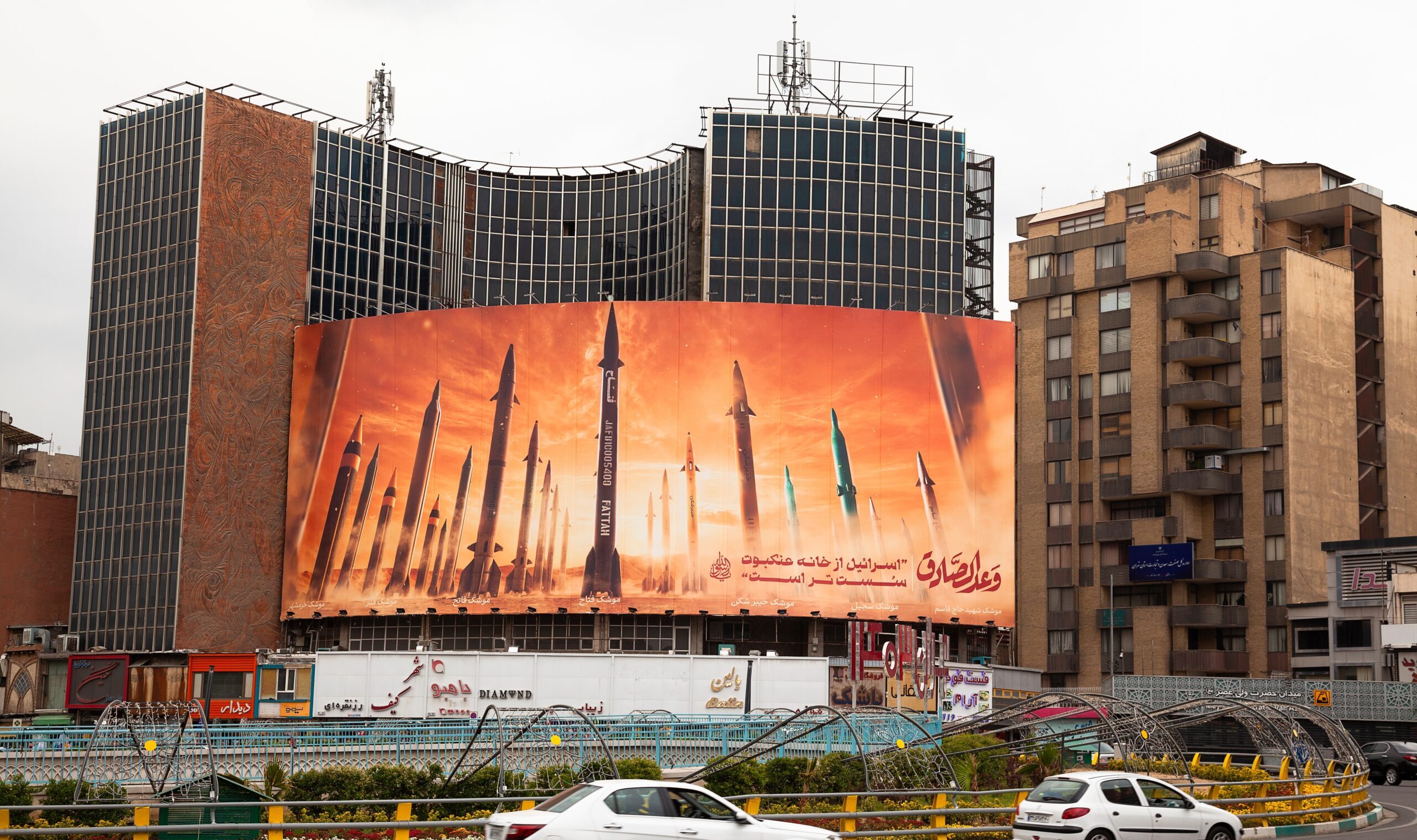Trump and the Storm of the Century
The U.S. is sleepwalking into disaster in the Middle East.

The fear in many nations’ capitals is that President Donald Trump’s return to Washington might make Israel feel more confident in attacking Iran. According to Mike Evans, founder of the Friends of Zion Museum in Jerusalem, “There is no world leader Trump respects more than Netanyahu.”
The evangelical leader also confides that President Trump would support an Israeli attack before his inauguration on the assumption that the destruction of Iran’s oil production facilities would devastate Iran’s economy, inducing Iran to end the war with Israel before President Trump assumes his office. This thinking by no means excludes an Israeli decision to strike Iran’s nuclear development sites as well.
What Trump will or will not do is unknown. When the illusive stillness in the standoff between Tehran and Jerusalem will end is also unknown.
One thing is certain: If America joins Israel in its war against Iran, the outcome will be a geopolitical showdown that could dramatically alter the world as we know it. It is the storm of the 21st century and, for the moment, the American ship of state is sailing right into it. At a minimum, Trump should demand answers from his civilian and military advisors to four important questions.
Question 1. What is the American purpose in waging war against Iran? Is Washington’s purpose to destroy the Iranian state? To destroy its capability to wage war against Israel? To eliminate Iran’s developing nuclear capability? Or to decapitate the Iranian state in the hope that the Iranian people will overthrow their national government?
All these goals demand serious study and analysis. In some cases, they overlap; in others they do not. The answers require identifying resources, manpower, capabilities, and the time needed to achieve these goals.
It is obvious that America’s air and naval forces will have to deliver powerful disabling strikes through dense Iranian air and missile defenses while potentially defending themselves and American military bases against attacks by Iranian and allied forces in the region. How long can these forces operate before their stocks of munitions are exhausted and their human and materiel losses are replaced?
Based on these answers, the stated objectives may or may not be attainable. National political and military leaders habitually plan and organize to achieve short, decisive outcomes, but wars always last longer than anticipated.
Question 2. How will U.S. military power achieve the objectives?
What is the right mix of weapon systems and munitions? What targets promise effects that profoundly shape Iran’s ability to fight? In the aftermath of the Second World War, studies of bombing effectiveness revealed that the most important contribution air power made to Germany’s defeat was the destruction of Germany’s fuel production and the transportation network to move it. Its second-most important contribution was to cause German air forces to defend Germany’s cities and industries, thus stripping the German army of its close air support. But thousands of tons of bombs were still dropped on thousands of targets with minimal impact on the German war machine.
Can air and missile power alone compel the Iranian State to submit to Israeli and American demands? To date, no amount of precision-strike forces linked to space-based and terrestrial, persistent intelligence, surveillance, and reconnaissance (ISR) capabilities has delivered victory in war. The Kosovo air campaign inflicted enormous damage on the Serbian economy, but its impact on Serbian ground forces was minimal. Yet once Moscow withdrew its promise of energy and food support to the Serbian people, the destruction of power plants and civilian and commercial infrastructure did induce the Serbian leadership to remove its forces from Kosovo.
Nevertheless, Serbian air defenses, despite their obsolete technology, were never degraded below 80 percent effectiveness. Precision strike has advanced in lethality and capability, but so has the military technology of the Iranian state. How far is unknown. In addition, it may turn out that air and missile attacks may prove incapable of halting the launch of tens of thousands of missiles, rockets and unmanned systems against Israel, as has been the case with Hezbollah.
Question 3. What is the desired end state? What does the President want Iran and the region that surrounds it to look like when the fighting ends?
This question is potentially the most difficult to answer. Unlike Iraq in 1991 and 2003 or Serbia in 1999 or Libya in 2011, Iran is not isolated. Iran has allies and supporters. By failing to define the end state in 1991, American operational strategic military planners were unprepared for the war’s outcome. The resulting peace was unsatisfactory to the long-term interests of the United States.
The Russian Foreign Ministry recently announced that “negotiations on the strategic security partnership between Russia and Iran are ongoing… with a particular focus on military cooperation.” China’s President Xi Jinping has assured Iran of China’s support in the defense of Iranian national sovereignty and security.
Even Saudi Arabia’s Crown Prince Mohammed bin Salman (MBS) advises against attacking Iran. During a recent summit of Arab and Muslim leaders, MBS stated, “The international community should oblige Israel to respect the sovereignty of the sisterly Islamic Republic of Iran and not to violate its lands.”
Saudi Arabia and the United Arab Emirates (UAE) are also making strategic financial moves. Saudi Arabia’s holdings of U.S. Treasury bonds have fluctuated significantly, falling to approximately $108.1 billion as of June 2023, a decline of over 41 percent since early 2020. If a conflict with Iran breaks out, the Saudis and Emirates will likely repatriate their wealth to the Arabian Peninsula and launch a “fire sale” of their U.S. treasuries, causing a financial crisis in the U.S. and the West on the scale of the Great Depression.
Less conspicuous, but no less important, is Turkey’s decision to break relations with Israel. President Recep Tayyip Erdogan has also signaled that Turkish Forces are ready to launch operations in Northern Syria to destroy U.S.- and Israeli-backed Kurdish forces that threaten Turkish and Syrian security. Turkish forces could easily be committed to the defense of Lebanon or Egypt.
Question 4. What is the strategic cost to the American people if Washington declines to participate in a regional war begun by Israel?
Since October 7, 2023, Israel’s political and military goals have extended far beyond the defense of Israeli national territory. Netanyahu seems confident that, with American financial aid and military support, Israeli forces can remove millions of Palestinian Arabs from Gaza and the West Bank, and Hezbollah from Southern Lebanon. Nevertheless, to secure Israel’s victory, PM Netanyahu insists that Iran and its proxies in Syria, Iraq, and Yemen must also be destroyed.
What do Netanyahu’s goals mean for the health of the American economy and the stability of the international system? Can Israel survive without attacking its numerous enemies?
In 1956, President Dwight Eisenhower refused to risk war with the Soviet Union over Hungary’s revolution against Communism. In the same year, Eisenhower refused to support the Anglo-French-Israeli intervention to seize the Suez Canal. In 1968, President Lyndon Johnson refused to employ American military power to halt the Soviet military intervention reasserting control of Czechoslovakia. None of these decisions harmed American national interests.
Eisenhower viewed the success of American Arms in the Second World War as the result of the carefully constructed grand strategy drawn by civilian leaders and executed by the senior leadership of the armed forces. Stanley Kubrick’s 1964 film, Dr. Strangelove or How I Learned to Stop Worrying and Love the Bomb, not only lampooned the thinking prevalent in the 1960s about nuclear war, but demonstrated the breakdown of this important policy-making process.
The film, starring Peter Sellers and George C. Scott, begins with a rogue Air Force general who orders nuclear-armed B-52 Bombers to attack targets inside the Soviet Union. Meanwhile, the president, who says he does not want to go down in history as a mass murderer, suddenly discovers that the Soviets created a doomsday machine consisting of cobalt bombs set to strike the continental United States if the Soviet Union is attacked.
Eventually, all the bombers are recalled, except for one B-52 commanded by Major T.J. “King” Kong. Unaware of the recall order, “King” Kong completes his mission, yelling and waving his cowboy hat as he rides the bomb to his death. The outcome is nuclear Armageddon.
Hardly the stuff of comedy, but it is a cautionary tale. Any number of accidents or false flags could precipitate conflict in the Middle East, but Dr. Strangelove need not become a reality. In the words of the great coach Vince Lombardi, “The measure of who we are is what we do with what we have.” It is up to Trump to use American power wisely.
The post Trump and the Storm of the Century appeared first on The American Conservative.



